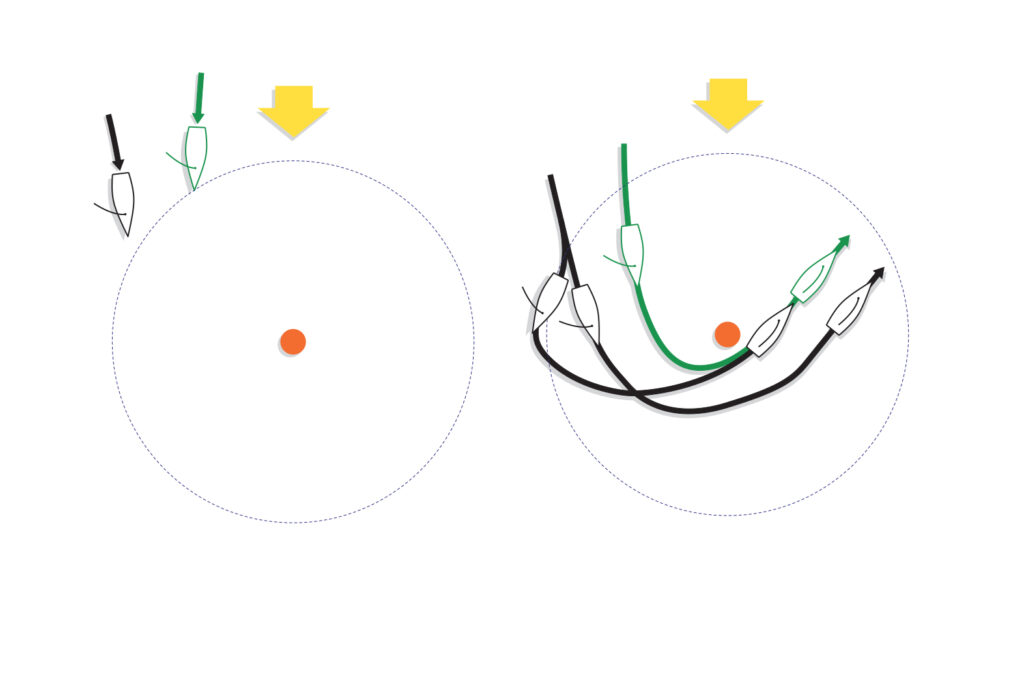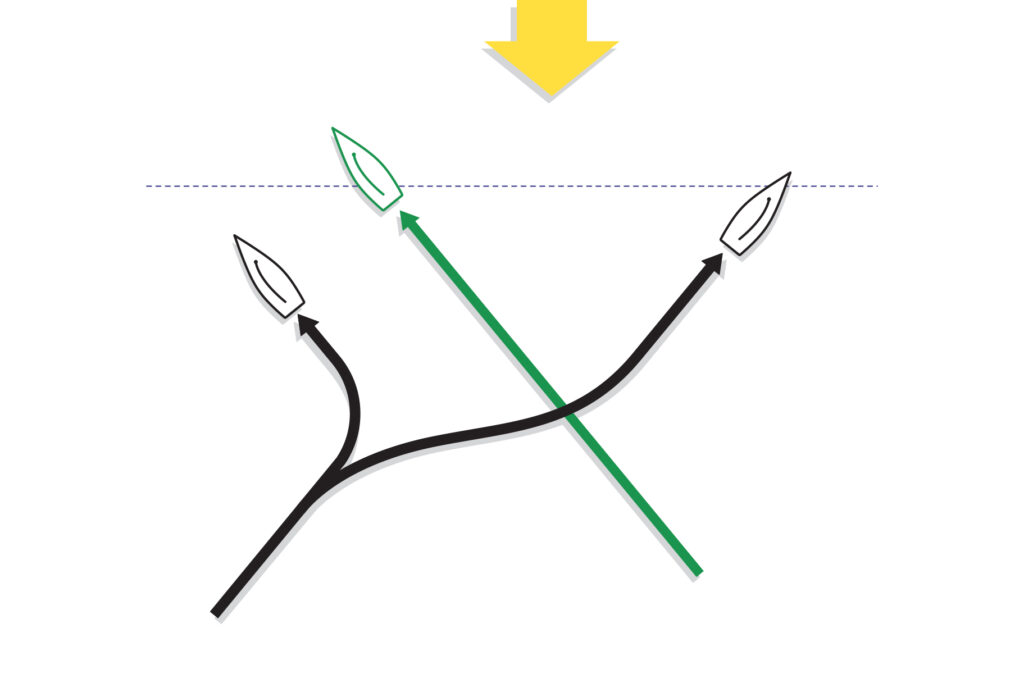A Guide to Tactical Risk Management
 As the two boats reach the mark zone, Green has room and Black has a difficult choice. It’s a 1.5-boatlength loss to slow down and round behind, and a similar loss to round outside. Both losses are significant, but there are no other options. Because the losses are about equal, it is Black’s strategy that dictates the final call. If Black wants to go right, then outside is the way to go. If Black wants the left, it needs to slow and round behind.
Kim Downing Illustrations
As the two boats reach the mark zone, Green has room and Black has a difficult choice. It’s a 1.5-boatlength loss to slow down and round behind, and a similar loss to round outside. Both losses are significant, but there are no other options. Because the losses are about equal, it is Black’s strategy that dictates the final call. If Black wants to go right, then outside is the way to go. If Black wants the left, it needs to slow and round behind.
Kim Downing Illustrations
It seems as if, when boats get near each other, they both lose something. Let’s look at the classic upwind port-starboard crossing. Suppose you are on port tack heading in phase to the right. Along comes a starboard tacker that you are not quite crossing. Short of fouling that boat, you have three options: tack, duck or double-tack (tack, pinch off the starboard-tack boat, then tack back). Which is the right move? The answer is simple: It’s the one with the least loss.
You need to resign yourself to the fact that each of these three options is a loss. There is no option that nets a gain on the fleet. There never is. The tack options will cost you one boatlength, assuming your boat loses that much in a tack. If it’s a bad tack, you lose even more. It follows then that the double-tack option will cost you two boatlengths. The duck option costs you 1.5 boatlengths (a half-boatlength duck gets you bow-to-bow, and then it’s another boatlength from there). Which is the right move? The tack, because it loses only one boatlength.
But that is just a baseline. You also need to layer on your strategy. You are sailing to the right side of the racecourse for a reason; in this case, you are lifted on port tack and want to stay in phase. It’s a rough guess, but you need to estimate how much you will lose if you get out of phase. Let’s say for this shift example, you estimate four boatlengths of loss. The tack option sends you out of phase at a cost of five boatlengths (one for the tack and four for sailing out of phase). The loss with the duck and the double-tack options are unchanged because they both keep you in phase with no loss. Which is the right move? Factoring in strategy, the duck is the new least-loss option. At a 1.5-boatlength loss, it wins out by a half-boatlength over tacking twice (two boatlengths) and is way ahead of tacking once (five boatlengths).
Use risk aversion as the tiebreaker. If it’s a close call, the double-tack option loses out to the duck by only a half-boatlength. A duck is straightforward, so that’s low-risk. The double-tack option is dicey because it relies on planting a solid lee bow, successfully pinching off the boat, then tacking to cross. Much more can go wrong with boathandling and a potential rules situation, so let’s call this high-risk. Ducking loses less and is lower-risk. Duck it is. I’m OK with taking the risk when the math says it’s the right thing to do. But unless it is compelling, I avoid the higher-risk option.
The amount of loss is dependent upon both the boat type and the conditions. If you sail a boat that tacks very well, such as a round-bottom dinghy, your tack loss might be close to zero with a solid roll tack in light air and flat water, but it might be one boatlength or more in big waves or chop. A larger keelboat likely won’t fare as well. There will likely be one boatlength lost in ideal (flat water) conditions and three boatlengths lost in waves or chop. Most boats don’t lose much when jibing, but a dinghy dropping off a plane compared with a boat still ripping along means that jibe could be quite costly. The point is that each boat has its own matrix of maneuvers and its respective loss through the range of conditions. You need to know your boat’s matrix for this process to work. You don’t have to identify the trade-offs of maneuvers to a small fraction, but you should know within about a half-boatlength for all maneuvers in all conditions.
 Black and Green are bow-to-bow on the open course. Black has two simple options as the port-tack and give-way boat: It can either tack or duck, both of which will result in some loss. The least loss is most often the duck. The tack, especially if slow, typically nets a greater, or in this case, an additional half-boatlength loss compared with the duck.
Kim Downing Illustrations
Black and Green are bow-to-bow on the open course. Black has two simple options as the port-tack and give-way boat: It can either tack or duck, both of which will result in some loss. The least loss is most often the duck. The tack, especially if slow, typically nets a greater, or in this case, an additional half-boatlength loss compared with the duck.
Kim Downing Illustrations
Unlike specific boathandling encounters that have a one-time loss—such as tacks and ducks—speed modes and dirty air have a continual loss over time. Pinching to hold your lane off the start might be a slow-burn loss of, say, four boatlengths per minute. If you need to hang in there for 30 seconds or so before you can tack into an open lane, that’s a loss of two boatlengths. Compare that against clearing out earlier into traffic that might require multiple ducks while weaving through a large pack. Waiting for 30 seconds in a tight lane at a loss of two boatlengths does not seem so bad if ducking a large pack or multiple boats costs you five.
Most leeward-mark decisions weigh the loss of going around outside the pinwheel versus the loss of slowing down and waiting to get in line. Slowing down is the right choice if you figure that doing so will cost you one boatlength, while going outside costs you three. The right answer is usually to slow down, but in a situation with a pile of boats jammed up, the outside route just might work. If you figure that it will cost you five boatlengths to stop while you wait for a large pack to round, going outside and losing only three lengths might be the least-loss move.
A windward-mark rounding has a different set of least-loss options. Getting on the layline early is a slow bleed. This needs to be compared to the loss of coming in late on port tack. Is tacking one minute out from the mark better than two extra tacks and some ducks right near the mark? If you expect to lose 10 boatlengths on a long starboard layline, the likely answer is yes. But it is risky, so you need to consider that too. I have found myself coming in late into an impossible situation and fouled, and I have also realized that there was no way in and had to duck 20 boats. High risk, high reward.
Letting people off the hook by waiving your rights is often the least-loss move. In a crossing situation when I am that starboard boat, I often hail the port tacker to cross and wave them through. Sure, I like to make friends by being courteous and letting them go, but it’s a selfish move. A duck will cost me maybe half a boatlength, and I expect that the sacrifice will likely be far better than having to do two tacks to clear, if they lee bow me. As a bonus, they just might return the favor later.
Boat-on-boat interaction is inevitable, and with each engagement, you lose distance to the fleet as a whole. You typically have options, but it’s not always immediately obvious which is best. It’s hard to give up your rights and duck a port tacker, slow way down at a leeward mark, or hang in there above a tough boat holding you high, but you need to understand your boat and have your strategy well in hand so that you can weigh your options and pick the one that is not as bad as the others. The right choice, of course, is the one with the least loss.
The post A Guide to Tactical Risk Management appeared first on Sailing World.
- Home
- About Us
- Write For Us / Submit Content
- Advertising And Affiliates
- Feeds And Syndication
- Contact Us
- Login
- Privacy
All Rights Reserved. Copyright , Central Coast Communications, Inc.